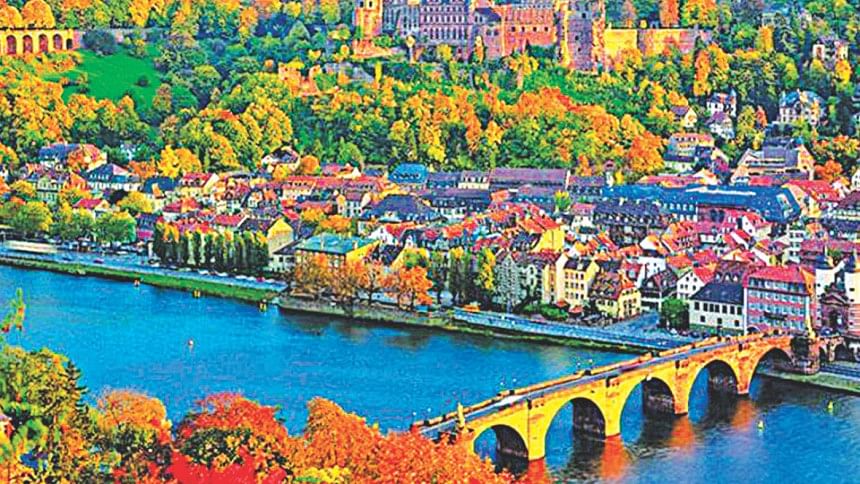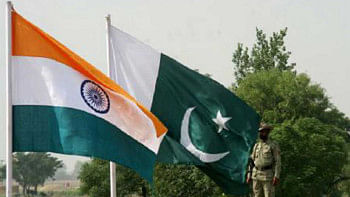Bewitching Heidelberg

Much like the famous German song "Ichhabmein Herz in Heidelberg verloren" by Fred Raymond, which later became the theme song of this celebrated city, I also lost my heart in Heidelberg. I was not the first and I am sure that I will not be the last. Many others, including celebrities such as Goethe, Hugo and Twain, to name a few, fell in love with Heidelberg. Given its romantic castle ruins, beautiful architecture in the old city, and serene walkways along the Neckar which flows along a valley, it is hard to stay immune to its charms.
I consider myself fortunate to have been able to call this fairy tale city my home for two years. My eight-year old son and I used to live in a tiny house nestled amid the lush green hills, only five minutes away from the Neckar River.
Heidi is beautiful through every season. Spring used to be my personal favorite. With the advent of Spring, the magnolias and cherry blossoms in seductive shades of pink competed for my attention. The mountains of Heidelberg draped themselves in gorgeous shades of emerald, as they towered over the Neckar which lay at its feet, as still as glass. Picnics on the bank of the river became a common sight, as did row boats, kites and barbecues. The fields surrounding our campus had a generous sprinkling of wildflowers of every color imaginable.
As I scampered between class and home, everyone around me seemed to be enjoying an ice-cream cone. It took enormous self-restraint to sit in front of the computer, with the sun shining brilliantly over the red sandstone buildings right outside my window. When I was not writing essays for my coursework at the university, or offering a walking tour to holidaymakers, I would set out to explore Heidelberg with my son, and we would grab our own ice cream cones.
As we walked along the cobblestoned alleys of Alstadt for the thousandth time, we would observe the sea of faces around us and try to separate the locals from the tourists, which became an interesting exercise. Every year thousands of tourists flocked to this picturesque city to get a whiff of its rich history.
The Alstadt, which means "Old City" in German, actually lives true to its name. Heidelberg escaped bombing in the World War II because it was not an industrial hub, and therefore, of no particular strategic interest to the Allies. Little wonder that unlike many German cities it has buildings dating back to the late Middle Ages and early Renaissance.
In fact, only the Altebruecke or "Old Bridge" was partially damaged by the Nazis themselves to prevent the Allies from entering the city. The bridge, later restored as a walkway for pedestrians, is almost never empty. From families with children chattering noisily, flustered and dazed tourists walking aimlessly, the lone cellist playing a melody in one corner to gooey-eyed couples "locking in their love"—there were always people on the bridge. Unless it was the dead of winter, of course! There is something magical about that bridge that makes one fall helplessly in love, a love so hypnotizing that one would never want to leave. No wonder it is considered as one of the most romantic spots in Heidelberg.
Towering over the Altstadt, the castle ruins of the late Medieval and early Renaissance period looks majestic. It looks even more striking at night when seen across the Neckar River, brilliantly illuminated. The castle can be reached either by walking up a steep, winding trail, or by taking the funicular railway, which dates back to 1890, from Kornmarkt station. Although, being a student, I possessed a semester bus ticket that could get me a discounted price on the funicular ticket, I always preferred to take the trail and soaked in the spectacular view of the city which lay at the foot of the hill.
The castle itself is an amalgamation of several buildings which were constructed over several centuries, which is apparent from the stark differences in their style of architecture.
Apart from the rich history of the castle buildings, the Elizabeth Gate, built overnight as a gesture of love, and the Grosses Fass, the world's largest wine barrel with a capacity of about 58,000 gallons, are "must-see items" for the tourists. There is even a wooden dance floor on top of the barrel, led by a staircase! The terrace is a perfect picnic spot. In spite of having visited the castle countless times, I cannot help but wonder at the far-reaching views over the Neckar River and the red rooftops of Alstadt.
Another popular site of Heidelberg is the Philosophenweg or the Philosopher's Way. Walking through steep fields, orchards and even vineyards on the slopes across the Neckar from the Altstadt on the winding path, you'll comes across panoramic views of the castle and the city. Moving further up along Schlangenweg or "Snake's path", will bring you to the Thingstätte, a Nazi-era amphitheatre.
To talk about Heidelberg and not mention its university is sacrilegious. Indeed, Germany's oldest university witnessed the rise of minds such as Hegel, Schumann, Bunsen and Heidegger. In fact, fifty-six Nobel Prize winners have been in some way or other connected to Heidelberg University. Established in 1386 with only four faculties, the Ruprecht-Karls-Universität Heidelberg now comprises 12 faculties. 30,000 students come to it from all over the world. I should add that its students pay no tuition fees. All undergraduate programs are conducted in German although a few graduate programs are entirely taught in English.
I thank the day that Heidelberg University chose me as its student, because when I returned to my homeland last year, I carried with me a treasure trove of fond memories, and the satisfaction of having lived in one of the most bewitching places in the world.
Afsana Tazreen is a Program Coordinator at FES in Bangladesh.

 For all latest news, follow The Daily Star's Google News channel.
For all latest news, follow The Daily Star's Google News channel. 



Comments